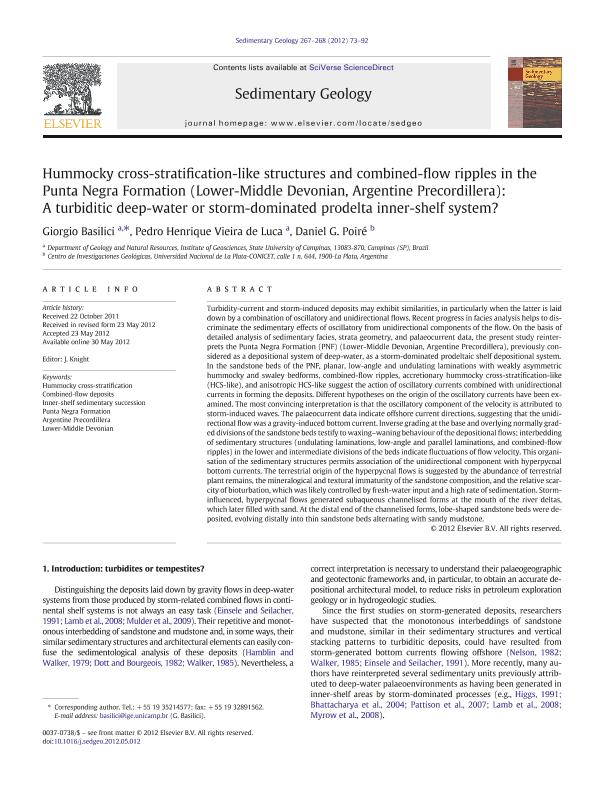Mostrar el registro sencillo del ítem
dc.contributor.author
Basilici, Giorgio

dc.contributor.author
de Luca, Pedro Henrique Vieira
dc.contributor.author
Poire, Daniel Gustavo

dc.date.available
2019-03-25T15:30:06Z
dc.date.issued
2012-08
dc.identifier.citation
Basilici, Giorgio; de Luca, Pedro Henrique Vieira; Poire, Daniel Gustavo; Hummocky cross-stratification-like structures and combined-flow ripples in the Punta Negra Formation (Lower-Middle Devonian, Argentine Precordillera): A turbiditic deep-water or storm-dominated prodelta inner-shelf system?; Elsevier Science; Sedimentary Geology; 267-268; 8-2012; 73-92
dc.identifier.issn
0037-0738
dc.identifier.uri
http://hdl.handle.net/11336/72415
dc.description.abstract
Turbidity-current and storm-induced deposits may exhibit similarities, in particularly when the latter is laid down by a combination of oscillatory and unidirectional flows. Recent progress in facies analysis helps to discriminate the sedimentary effects of oscillatory from unidirectional components of the flow. On the basis of detailed analysis of sedimentary facies, strata geometry, and palaeocurrent data, the present study reinterprets the Punta Negra Formation (PNF) (Lower-Middle Devonian, Argentine Precordillera), previously considered as a depositional system of deep-water, as a storm-dominated prodeltaic shelf depositional system.In the sandstone beds of the PNF, planar, low-angle and undulating laminations with weakly asymmetric hummocky and swaley bedforms, combined-flow ripples, accretionary hummocky cross-stratification-like (HCS-like), and anisotropic HCS-like suggest the action of oscillatory currents combined with unidirectional currents in forming the deposits. Different hypotheses on the origin of the oscillatory currents have been examined. The most convincing interpretation is that the oscillatory component of the velocity is attributed to storm-induced waves. The palaeocurrent data indicate offshore current directions, suggesting that the unidirectional flow was a gravity-induced bottom current. Inverse grading at the base and overlying normally graded divisions of the sandstone beds testify to waxing-waning behaviour of the depositional flows; interbedding of sedimentary structures (undulating laminations, low-angle and parallel laminations, and combined-flow ripples) in the lower and intermediate divisions of the beds indicate fluctuations of flow velocity. This organisation of the sedimentary structures permits association of the unidirectional component with hyperpycnal bottom currents. The terrestrial origin of the hyperpycnal flows is suggested by the abundance of terrestrial plant remains, the mineralogical and textural immaturity of the sandstone composition, and the relative scarcity of bioturbation, which was likely controlled by fresh-water input and a high rate of sedimentation. Storm-influenced, hyperpycnal flows generated subaqueous channelised forms at the mouth of the river deltas, which later filled with sand. At the distal end of the channelised forms, lobe-shaped sandstone beds were deposited, evolving distally into thin sandstone beds alternating with sandy mudstone. © 2012 Elsevier B.V.
dc.format
application/pdf
dc.language.iso
eng
dc.publisher
Elsevier Science

dc.rights
info:eu-repo/semantics/openAccess
dc.rights.uri
https://creativecommons.org/licenses/by-nc-sa/2.5/ar/
dc.subject
Argentine Precordillera
dc.subject
Combined-Flow Deposits
dc.subject
Hummocky Cross-Stratification
dc.subject
Inner-Shelf Sedimentary Succession
dc.subject
Lower-Middle Devonian
dc.subject
Punta Negra Formation
dc.subject.classification
Meteorología y Ciencias Atmosféricas

dc.subject.classification
Ciencias de la Tierra y relacionadas con el Medio Ambiente

dc.subject.classification
CIENCIAS NATURALES Y EXACTAS

dc.title
Hummocky cross-stratification-like structures and combined-flow ripples in the Punta Negra Formation (Lower-Middle Devonian, Argentine Precordillera): A turbiditic deep-water or storm-dominated prodelta inner-shelf system?
dc.type
info:eu-repo/semantics/article
dc.type
info:ar-repo/semantics/artículo
dc.type
info:eu-repo/semantics/publishedVersion
dc.date.updated
2019-03-18T14:11:15Z
dc.journal.volume
267-268
dc.journal.pagination
73-92
dc.journal.pais
Países Bajos

dc.journal.ciudad
Amsterdam
dc.description.fil
Fil: Basilici, Giorgio. Universidade Estadual de Campinas; Brasil
dc.description.fil
Fil: de Luca, Pedro Henrique Vieira. Universidade Estadual de Campinas; Brasil
dc.description.fil
Fil: Poire, Daniel Gustavo. Consejo Nacional de Investigaciones Científicas y Técnicas. Centro Científico Tecnológico Conicet - La Plata. Centro de Investigaciones Geológicas. Universidad Nacional de La Plata. Facultad de Ciencias Naturales y Museo. Centro de Investigaciones Geológicas; Argentina
dc.journal.title
Sedimentary Geology

dc.relation.alternativeid
info:eu-repo/semantics/altIdentifier/url/https://www.sciencedirect.com/science/article/pii/S0037073812001492
dc.relation.alternativeid
info:eu-repo/semantics/altIdentifier/doi/https://doi.org/10.1016/j.sedgeo.2012.05.012
Archivos asociados
